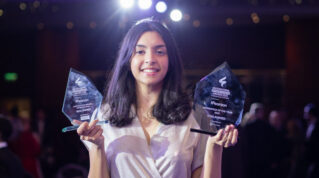The expectation of college leavers’ tech literacy has changed drastically in the past decade – even the past three years. Previously, a cursory mention of Microsoft Office on your CV was enough to suggest you were reasonably tech literate. Now, we live in a different world.
The usual assumption is that a young person’s tech skills are greater than those before them, as they are viewed as having grown up with tech. This assumption has several flaws.
To begin with, the reality of tech in the workplace is very different to the technologies young people encounter. Social media, messaging apps and gaming won’t get them far. Even when it comes to VR itself, there is a world of difference between a gaming application and its various workplace uses.
This assumption is also based on the idea that every young person has grown up with access to a smartphone and/or a PC as well as the time, data and guidance to explore a range of applications. Educators know that simply isn’t the case. Digital poverty is real. Across NCG (as at all schools and colleges) students from different backgrounds are at a very varied range of starting points. For some, tech is an enabler to education and the workplace. For others, it is a barrier.
For these reasons and more, it’s best not to make assumptions about any young person’s tech skills but to create a more inclusive space with a bottom-up approach to tech literacy.
From remote to virtual learning
Balancing inclusivity with innovation is a constant consideration. In the next five years, virtual and augmented reality (VR/AR) are likely to take off in a big way. The biggest opportunity this presents is in making the inaccessible, accessible. They promise to mitigate the cost, health and safety, time and planning challenges of taking students to real work environments like construction sites, factories and labs and offering immersive experiences to all learners, no matter where they are.
At NCG, we’re using these technologies in subject areas like construction where site access can be dangerous and in the automotive sector where the switch from the internal combustion engine to the electric motor is in full flow but access to new, cutting-edge facilities can be challenging.
I sit at the ‘edtech fanatic’ end of the spectrum. I believe fervently that we need to prepare students for the future, not just for the here and now, and that VR/AR will help us do that.
However, we know we are working with a huge range of experiences, preferences and abilities among students and staff. The speed at which we deployed digital learning during lockdown was unprecedented and broadly successful, but not everyone thrives in a digital or remote environment.
Time for reflection
I can absolutely see a future where VR headsets, augmented reality and meeting in the metaverse are the norm, for both teachers and students. Some may see this as a threat to the traditional classroom situation. This is a valid feeling, and it is important to reassure everyone that these technologies are complementary. There will always be times when we ‘switch off’, to make time for face-to-face discussion and ideation, for finding sources of inspiration and using our imaginations.
Delivering this inclusive vision is a matter of small, incremental changes that offer time to pause and reflect. For us, a phased approach means building on blended learning first, for example by using 360 imagery and some immersive experiences from a desktop.
While we do this, we are mindful of workload implications. Indeed, one of the very reasons we are also exploring the adoption of AI is to reduce administrative time to support colleagues to upskill and develop their classroom practices.
Because in the end, a considered, phased approach that takes everyone on the journey, will be critical to a successful digital transformation in education. If only there was a VR simulation of that near future that I could show you.















Your thoughts